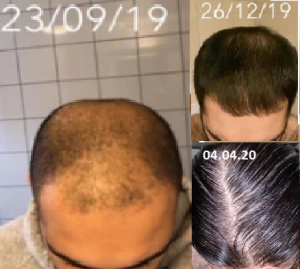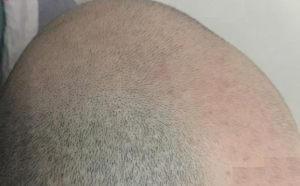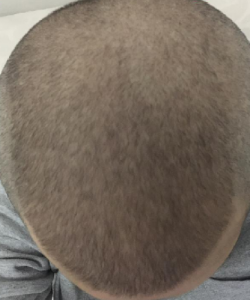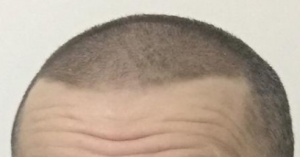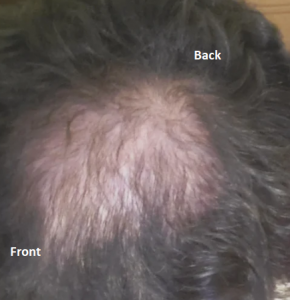I have been on fin for 9 months and haven’t noticed any regrowth so I decided to add 1mm derma stamping about a month ago. Still haven’t seen anything. Are fin and micro-needling known to be successful together or is it just min and micro-needling that go well together? I really don’t want to start min cause I don’t want to have to apply it every day and I’m deathly scared of the initial shed. Any advice is appreciated!
The needles must go down at least 1 mm to get the stimulus from the microneedling as that is where the critical stem cells are located. They don’t have to go deeper than that. You should add minoxidil to the skin immediately before using microneedling. That, according to the literature I read, gives the best results. To deal with the pain, you can use a topical anesthetic from the pharmacy, leave it on for at least 15 minutes before using the microneedling and it should reduce the pain of the needles going through the skin.
People with fine hair often have a see-through hair appearance. People with coarse hair, almost never do.
In your long experience, have people who responded well to the drug initially maintain their growth over a long period of time, say over 10 years? Thank you
Most people often maintain the effects of the drug if they stay on it, but some lose the full effectiveness if the genetic hair loss accelerates or they stop the drug.
I have a fraternal twin who at 21 hasn’t started thinning yet while I have some minor loss.
We have had quite a few identical twins. I wrote about such a case here: https://baldingblog.com/transplanting-identical-twins/ Fraternal twins are not the same as they may have inherited different balding patterns.
I am 23 and my hair is falling. I used Minoxidil for my beard and it was amazing, because my hair grew strong and it helped to have new hairs. But I leaved it, because I had inusual and strong hearbeats and I am losing all of the beard that grew from it. So, is it worth to try Fin? The side effects scare me.
I use finasteride for men like you in my practice and many of them have taken them since the drug was introduced two decades ago; however, I go through a full disclosure of all of the risks (which are small but real) so you must understand the balance between benefits vs risks. You should see a doctor about the minoxidil side effects.
I’m 25 years old. I was starting to lose my hair when I was 16. It was very rapid process so when I was 20 my situation is almost NW7. 132 days ago I decided to take this regime ( I don’t want to mention about decision phase): dermaroller 0.5 mm x1week, (dut(0.5) once everyday+ minox %5 twice everyday + nizoral 2-3 times per week with no side effects), biotin(10000) + zinc(50) + d3(5000) + collagen peptides(tablet) + omega3(with fish oil) all of them x1 everyday, ogx biotin shampoo
Everything was good for me in just 2 months. It was like a miracle you know. My hair like born again. My head was full of baby hair and they were getting stronger day by day (or its just it seemed to me like that)
This is great. You have with your combination of approaches solved your hair loss problem for the moment. I have little doubt that the best part of what you did was: big 3 + dermaroller 0.5 mm x1week (dut(0.5) once everyday+ minox %5 twice everyday + nizoral 2-3 times per week with no side effects). There are excellent studies that show that the use of a dermaroller plus minoxidil and finasteride (in your case dutasteride) can reverse hair loss in young men. I give you great credit for sticking to this routine. Keep in mind that both dutasteride (or finasteride) plus the minoxidil must stay on-board to hold on to your hair, possibly without more dermaroller work.
I agree he got a really good result so if he went to a different surgeon maybe he would get a bad result. So if he had a bad result, would it be because of the surgeon’s crappy artistic skills? or the patients hair quality? or is it because of the technicians that plant the follicles? What’s the most common reason why people sometimes get not very good looking transplant?
Surgical failures come in many flavors: (1) the patients not establishing realistic expectations with his surgeon’s communication skills, (2) poor surgical planning (just targeting # of grafts that don’t fit into a patient’s Master Plan, (3) surgeons who do it for the $$ and never learned the art and technique through proper training, (4) over-hyped marketing to set unrealistic expectations on all hair transplant buyers, (5) unskilled surgeon, (6) lack of experience and disciplined team with a focus on quality control, (7) surgeries that last too long leaving the grafts out of the body too long, (8) Grafts that are traumatized at any point from the time they are taken out of the body until they are put back into the recipient site and this includes poor placement of the grafts, (9) poor site making by the surgeon producing hair that points in the wrong direction, (10) Poor post operative protocols resulting in loss of grafts, infection from poor techniques, (11) poor patient selection as patients may have diseases that will kill some or all of the transplanted grafts, or the patient doesn’t have the quality or quantity of hair needed to address the bald area. Bad doctors (there are a few) just care about making money so they do hair transplants because they get paid up-front. For these rotten applies, there is motive to take responsibility for these unfortunate patients.
There are unique problems with FUE including poor harvesting distribution and too much graft damage when grafts are removed. Poor distribution can produce balding in the donor area or necrosis in the donor area (see here: https://baldingblog.com/collection-victim-photos-internet-harvested-depleted-donor-areas/). There are also unique problems with strip surgeries in the hands of inexperienced surgeons including wound problems, nerve damage, bleeding, AV malformations (both FUE and Strip surgeries) and poor planning or improper placement for the location of the strip or taking out too wide a strip to produce increased scarring and even infection and necrosis.
I can write a book about this question, but I will stop here.
Everyone in My House Is Losing Head and Body Hair. We Just Found out That There Is Black Mold in the House, Could This Cause It?
Black mold can cause multiple health problems and it is common in many homes, more common than most people realize. I don’t have any real experience with Black Mold other than what I read. Best to start off with your family doctor as both your living quarters must be addressed as well as the health of everyone exposed to the black mold.
Everything taken under the tongue goes in faster, but there is no point to it as it is tissue fixation at the hair level that is important, not the blood level
I live in a small town in a 3rd world country and have to order finasteride from another city as its not available in my town. I had already ordered some but due to city level quarantine, the courier service is closed and I don’t have any fin left. How long before it loses its effects?
When stopping finasteride then the effects may last 3 weeks before you start seeing ‘catch-up hair loss’. Call your doctor’s office and they should renew the medication for you. The US postal service is working during the crisis and the pharmacies can mail it to you.
Thanks Dr. Rassman. Any basis for why it will not absorb? Minoxidilmax.com one of the longest running topical finasteride sellers said this on DIY:
“If you want to make your own topical finasteride at 0.1 percent to save money, you should be able to do that with the right tools and material. No need to be a scientist to do so. The only tool you need is a scale that is accurate to 1mg level. All you need to do is to weigh 60 mg of pure finasteride power and pour it into a bottle of 60 ml minoxidil solution, close the bottle and shake it for 10 minutes.
The real challenge here is not how to make it but how to obtain good quality of finasteride material. Some people choose to use 5 mg finasteride pills (Proscar). In this case, you will need to pulverize 12 pills and then put the powder into a bottle of 60 ml minoxidil solution. Shake it very hard for 10 minutes. Let the bottle stand still for overnight and pour the clear solution to another bottle for use. The reason why it is recommended to dissolve the powder into a minoxidil solution is that it has right solvent that ensures the good absorption of the topical finasteride. You can’t just use pure alcohol as the solvent, because it evaporates too faster and you will end up with flakes of finasteride on your scalp that will never be absorbed.
With the 0.1% topical solution, you receive 1 mg finasteride if you use the solution once a day. If you use the homemade solution above twice daily, your finasteride dosage is actually 2 mg a day.”
This question is a moving target tied to instrumentation issues. Some doctors have done a) half FUE and b) half strip and measured growth differences and there were none. There are certain patients that FUE will cause damage, that group is a subset of those I called Fox negative patients in my original article. This group of Fox negative patients has contracted to a smaller number because of better and better instrumentation that has developed over the years. In that small sub-set of patients, there is no doubt that FUE is an inferior surgery and that sub-group, unfortunately, can’t be identified in advance, so each individual takes some risk that they may be in this sub-group when they elect to get FUE. Maybe this sub-group is 5% of all FUE patients, maybe less, but for them it is 100% less quality surgery because there is more damage to the grafts during harvesting. This presents the problem as if it is black and white, but there are gray areas in this sub-group that may make the sub-group larger than 5%. The strip doesn’t have that risk.
Here is a hairline I repaired and created a Brad Pitt hairline in one surgery: https://baldingblog.com/repair-of-hairline-transplants-photos/ We do this all of the time, see here: https://newhair.com/before-and-after/hair-transplants-men/#results
Page 220 of 1240

